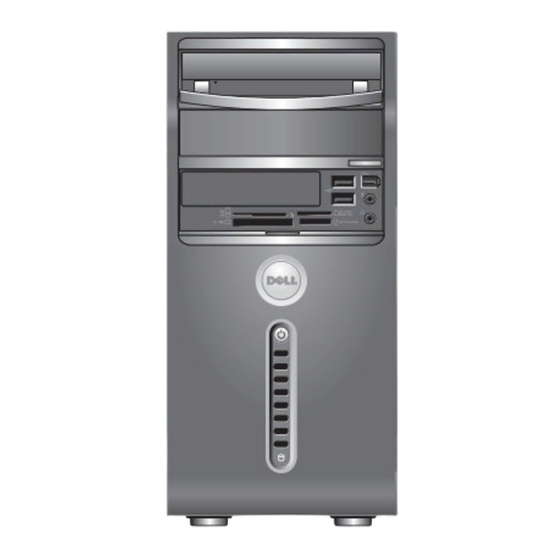Dell DCMA Manuel d'entretien - Page 30
Parcourez en ligne ou téléchargez le pdf Manuel d'entretien pour {nom_de_la_catégorie} Dell DCMA. Dell DCMA 37 pages.

SATA5
System Info
Memory Info
Advanced
CPU type
L2 Cache
Advanced Chipset Features Indicates amount of video memory (32 MB by default).
Integrated Peripherals
CPU Configuration
USB Configuration
Power
Power Management Setup
ACPI Suspend Type
Remote Wake Up
Auto Power On
Auto Power On Date
Auto Power On Time
AC Recovery
Boot
Boot Device Priority
Removable Device Priority
Hard Disk Boot Priority
CD/DVD Boot Priority
Boot Settings Configuration Configure Fast Boot, Numlock and Keyboard errors.
Security
Exit
Exit Options
Boot Sequence
This feature allows you to change the boot sequence for devices.
Boot Options
Hard Drive — The computer attempts to boot from the primary hard drive. If no operating system is on the drive, the computer generates an error
l
message.
CD/DVD Drive — The computer attempts to boot from the CD/DVD drive. If no CD/DVD is in the drive, or if the CD/DVD has no operating system, the
l
computer generates an error message.
USB Flash Device — Insert the memory device into a USB port and restart the computer. When F12 = Boot Menu appears in the upper-right corner of
l
the screen, press <F12>. The BIOS detects the device and adds the USB flash option to the boot menu.
NOTE:
To boot to a USB device, the device must be bootable. To ensure that your device is bootable, check the device documentation.
Changing Boot Sequence for the Current Boot
You can use this feature to change the current boot sequence, for example, to boot from the CD/DVD drive to run the Dell Diagnostics on the Drivers and
Utilities media. On completion of diagnostic tests, the previous boot sequence is restored.
1. If you are booting to a USB device, connect the USB device to a USB connector.
2. Turn on (or restart) your computer.
3. When F2 = Setup, F12 = Boot Menu appears in the upper-right corner of the screen, press <F12>.
If you wait too long and the operating system logo appears, continue to wait until you see the Microsoft Windows desktop. Then shut down your
computer and try again.
Great user manuals database on
Displays the SATA drive integrated on SATA5.
Lists the BIOS version, system name, asset tag, and service tag.
Indicates amount of installed memory, memory speed, channel mode (dual or single), and type of memory installed.
Indicates the type of CPU installed.
Indicates the amount of CPU L2 cache.
Allows you to enable or disable the integrated devices and ports on your system.
Allows you to enable or disable the CPU features that enhance the performance of the system.
Allows you to enable or disable the USB controller.
Specifies the ACPI suspend type. The default is S3.
This option turns on the computer when a user tries to access the computer through the LAN.
Enables you to set an alarm to turn on the computer automatically.
Enables you to set the date to turn on the computer automatically (0 by default).
Enables you to set the time to turn on the computer automatically (0:00:00 by default).
Off; On; Last (Off by default).
Sets the boot device sequence. Only the bootable devices that are connected to the computer are listed as options.
Sets the boot priority among the attached removable devices.
Sets the hard drive boot priority. The items displayed are dynamically updated according to the hard drives detected.
Sets the CD/DVD drive boot priority. The items displayed are dynamically updated according to the hard drives detected.
Provides options to enable, disable or change the passwords.
Provides options to Exit Saving Changes, Exit Discarding Changes, Load Setup Default, and Discard Changes.
UserManuals.info
